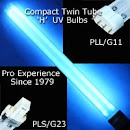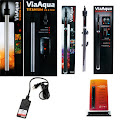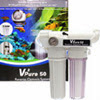Streptococcus, Fish Eye Infections
By Carl Strohmeyer-PAMR 35+ years experience
Updated 1/26/2019
This article deals with the most common gram positive bacterial infection affecting fish; Streptococcus iniae, and agalactiae as well as closely related bacterial groups; Lactococcus , Enterococcus , and Vagococcus.
Gram Positive Reference: Aquarium Medications; Gram Positive & Negative
 The most common symptom these bacteria will show as cloudy eyes and although majority of most aquarium bacterial infestations are gram negative, most eye infections are generally gram positive and caused by Streptococcus or related bacterium
The most common symptom these bacteria will show as cloudy eyes and although majority of most aquarium bacterial infestations are gram negative, most eye infections are generally gram positive and caused by Streptococcus or related bacterium
Occasionally Aeromonas in freshwater or Vibrio in saltwater will show up as eye infections, especially in “Pop Eye”.
In this case, following treatment for Aeromonas and Vibrio are is recommended as these are gram negative anaerobic & aerobic bacteria.
Please see this article for more:
Treatment and Identification of Aeromonas and Vibrio in Aquariums and Ponds
Although “Cloudy Eyes” (corneal opacity-whitish eyes) is the most common symptom of these gram positive infections, other symptoms are possible such as:
- "Pop-eye" (though usually caused by Aeromonas),
- Hemorrhages in or around the eye
- A “milky” slime
- Erratic swimming
- Swim bladder issues (inability to regulate buoyancy) & lethargy
- Darkening of body (such as a “black moldy appearance
- Occasionally Streptococcus can appear as a mouth 'fungus', on the gill plate, base of the fins, vent/anus, or elsewhere on the body although usually this is a symptom of Columnaris or Saprolegnia.
Reference: Columnaris & Saprolegnia
On rare occasions Streptococcus may be a cause of Dropsy.
As well some cases of “False Neon Tetra Disease” (FNT) may also be caused by Streptococcus.
Further Reading:
*Dropsy in Fish
*Neon Tetra Disease; FNT
ADVERTISEMENT
Often fish with Streptococcus iniae infections will not eat, which can complicate treatment for this bacterium when it is internal, especially for freshwater fish which do not drink water they are contained in (unlike most marine fish).
Further Reading: Do Fish Drink?
Most bacterial diseases of fish are opportunistic (such as Aeromonas or Columnaris).
Streptococcus on the other hand, does not seem to be a truly opportunistic pathogen, as it can be more aggressive than many other environmental bacteria.
In one experimental study (Ferguson et al. 1994), populations of zebra danios and white clouds exposed to high concentrations of Streptococcus in the water experienced 100% mortality within 2-4 days of exposure.
For this reason it is important that Streptococcus infections be quickly identified and managed to prevent major losses.
It is also noteworthy that recent studies have also shown growing incidents of this bacterial infection in fish farming, which is where most of the research into Streptococcus in fish is made available from.
In fact this problem has become severe enough among Tilapia and Trout farms that a vaccine is now in the testing phase for Streptococcus iniae.
Reference: First Live-Attenuated Vaccine for S. Iniae in Development
Fish that have been documented most susceptible include rainbow sharks, red-tailed black sharks, rosy barbs, danios, and some tetras and some cichlids.
TREATMENT
 For most “full blown” Streptococcus infections (not necessarily a mild eye infection), Erythromycin Phosphate is often the drug of choice.
For most “full blown” Streptococcus infections (not necessarily a mild eye infection), Erythromycin Phosphate is often the drug of choice.
Mortality should cease within 48 hr of treatment with the correct antibiotic if complicating factors are not present.
If the disease is internal, this therapy may be difficult because commonly sold erythromycin sulfate does not absorb well, and this case treatment with Neomycin enhanced foods foods is recommended.
Further Reading: Aquarium Medications; Fish Food Delivery
Recommended Product Sources:
*AAP Myacin (SUPERIOR Erythromycin Phosphate) (this product is a much better choice over the lessor Erythromycin Sulfate found in API Erythromycin or Mardel Maracyn)
*API Erythromycin from AAP
*SeaChem Neoplex (Neomycin) from AAP
It should be noted that although Erythromycin is the drug of choice, because it is an effective anti gram positive bacterium medication, it is also very hard on nitrifying bacteria, so having cultured sponge filters or other “seasoned” filter media to replace during and/or after treatment is very important since Streptococcus is not opportunistic. Many opportunistic bacterium such as Columnaris may follow, especially if ammonia/nitrites rise during or after treatment.
Further Reference: Aquarium Nitrogen Cycle; Use of Medications
Although generally the antibiotic of choice, sometimes Streptococcus bacterium can build a resistance to Erythromycin (as well sometimes destruction of tank environment from the use of Erythromycin can be a double edged sword that renders this antibiotic ineffective especially if tank conditions are not closely monitored).
In this case, Doxycyline or Tetracycline Hydrochloride may be a good substitute with Doxycyline more often being the better choice.
Tetracycline is not without its side effects either and its use can severely lower red blood cell counts in fish, so increasing circulation is a must.
As well, it's hard on nitrifying bacteria and tends to cause a buildup of brown foam. Tetracycline or Doxycyline should never be combined with Erythromycin.
Further Reading: Aquarium Medications Part 2; Tetracycline
Recommended Product Sources:
AAP Fin & Body Cure (Doxycyline)
Tetracycline from AAP
Other Potential Treatments Include Combinations Of:
- Erythromycin and Nitrofurazone (Furan 2)
Product Source: Furan 2 (Nitrofurazone) from AAP - Kanamycin combined with Nitrofurazone (Furan 2) (Nitrofurazone is especially useful for topical infections that may show as a milky slime) or Neomycin (in food for suspected internal infections).
Product Sources:
AAP Spectrogram; Kanamycin/Nitrofurazone Wide Spectrum Combination (1st choice over purchasing Kanaplex & Furan 2 separately as this already blended combinations works better synergistically).
Kanacyn (Kanamycin) from AAP - Minocycline in the same combinations in place of Kanacyn.
The advantage of possibly using Kanacyn is that this medication (combined with Nitrofurazone) can also prevent/treat opportunistic Columnaris or Aeromonas infections that may arise.
Melafix is a reasonable preventative treatment and may be effective for mild Streptococcus infections.
Sometimes for very mild eye infections (no other symptoms) Melafix is the only "in-tank" treatment you may need to use (outside of direct application of treatment).
Further Reading: Aquarium Medications Part 4; Organic Treatments
Recommended Product Source: Melafix from AAP
 If eyes are directly affected (and the only primary target of this infection), removing the fish and treating the fish directly in the eyes with Silver Nitrate followed by Potassium Dichromate IS EXTREMELY effective. The Silver Nitrate immediately destroys the infection then the Potassium Dichromate immediately stops the reaction.
If eyes are directly affected (and the only primary target of this infection), removing the fish and treating the fish directly in the eyes with Silver Nitrate followed by Potassium Dichromate IS EXTREMELY effective. The Silver Nitrate immediately destroys the infection then the Potassium Dichromate immediately stops the reaction.
The only problem being that Silver Nitrate is hard to find, other than AAP, sometimes photo lab supply businesses may have it.
Pictured to the right is Eye Fungex by AAP containing Silver and Potassium Dichromate..
Another choice is Merbromin, which too can be swabbed, painted, or dropped directly on the eyes. While not as effective as the Silver Nitrate/Potassium Dichromate combination, it is also easier to use.
Potassium Permanganate is reasonable third choice for this direct eye application and Methylene Blue a forth choice for direct application.
Either way, sometimes the only “in tank treatment” that may have to followed up with when the eyes are treated directly is Melafix or Melafix/Pimafix combination(used in the main tank or hospital tank, not in a bath).
Recommended Product Sources:
*AAP Eye Fungex
*AAP Merbromin (Wound Control)
*AAP MethyBlu (Premium Methylene Blue)
Medicated Baths may also be a very useful part of treatment for external Streptococcus infections in fish.
These would be twice daily for 30 minutes and I recommend the use of Methylene Blue combined with a double dose of Erythromycin or Tetracycline, or even Usnea
Recommended Product Source: Methylene Blue from AAP
Further Information:
*Aquarium Disease Prevention; Baths
*Fish Baths; Complete Information
*Usnea as a Treatment for Fish
If you suspect that you have a group of fish with a Streptococcus infection, the affected population should be isolated from all others. If possible, have dedicated equipment (nets, siphon hoses) for these fish.
PREVENTION
Since Streptococcus is not as opportunistic as discussed earlier, prevention is VERY key to stopping this bacterium. This would include UV Sterilization, medicated baths or quarantine of ALL new fish and if at all possible:
See these articles:
* “Aquarium Disease Prevention”
*UV Sterilization for Aquarium or Pond; Why it should be used
Although Streptococcus does seem to occur more frequently at warmer temperatures, it can occur at any time of the year.
Studies in marine systems in Japan Kitao et al. 1979, indicate that Strep may be present in salt water and mud, with higher incidence in the water during summer months.
Source: Distribution of Streptococcus sp. in Seawater and Muds around Yellowtail Farms
Nets, siphon hoses, vacuums, etc should ALL be soaked in Potassium Permanganate (or even bleach) prior to use in other tanks if you have more than one aquarium.
Recommended Product Source: Clear Water; Potassium Permanganate, from AAP
Use of anti-septic treatments such as Melafix, especially after injury or similar is helpful for prevention or even treatment early in Streptococcus infections.
Think of it this way, many human infections (including Staph) are common and simple treatments with products such as Neosporin is all that is necessary in minor injuries to prevent a major infection.
Although Melafix has little or NO anti gram negative bacterial abilities, it is an excellent preventive even for diseases such as Columnaris from getting a “foothold” by killing off disease pathogens such as Streptococcus that may be followed by Columnaris.
Further References:
*Streptococcus In Tilapia
Copyright Carl Strohmeyer
Other Recommended Reference & Product Sites

Freshwater Aquarium Care; Basics to Advanced
Are you looking for an informative and friendly Aquarium Forum to help with your fish problems (or simply to share your experience)?
Consider this forum with a friendly family atmosphere:
Everything Aquatic Aquarium Forum

TMC Premium Fluidized Sand Bed Filters
Premium, second to NONE Aquarium Bio Filters, that with optional Oolitic Sand, also maintains essential aquarium calcium levels, alkalinity, & electrolytes that are important to ALL Marine life, Goldfish, African Cichlids, Livebearers & more

Aquarium Sponge Filters
The Premium ATI Hydro Sponge Filter, from the only online seller with professional use dating back to 1978 (prior to the Internet)

UV Bulbs; Page 1
As noted above, changing these PREMIUM bulbs/lamps every 6-12 months is essential for a properly functioning UV Sterilizer

Fish Nutrition
Complete information from fish food building blocks to sources and much more

AAP Custom Super Premium by Fish Food Guru Clay Neighbors
There is simply NO better prepared fish food; NOT Repashy, New Life Spectrum, or NorthFin, etc.
Best energy levels, best fiber content, best protein optimization, no added supplements.
The best in Quartz, Under gravel, and Titanium Submersible Heaters:

Aquarium Heaters
Reliable Via Aqua Submersible Quartz Aquarium Heater
The Best in Value UV Sterilizers:
*Aquarium & Pond UV-C Sterilizers/Clarifiers

*COMPACT UV STERILIZERS, Terminator 7 watt to 36 watt
*TMC PREMIUM High Dwell Time Pond/Aquarium UV Sterilizers
TMC V2 RO Filter systems; the very best you can buy with TDS meter (far superior to 4 stage RO/DI systems sold via Bulk Reef Supply, Amazon, or eBay that use the inferior cellulose triacetate membrane made by Dow):
 Reverse Osmosis Aquarium Water Filters; with TDS Meter
Reverse Osmosis Aquarium Water Filters; with TDS Meter
ADVERTISEMENT